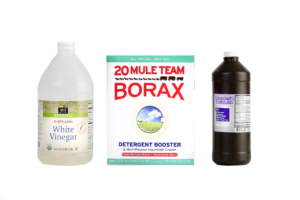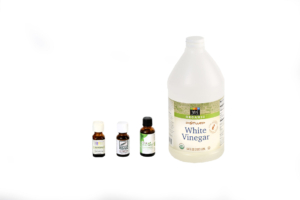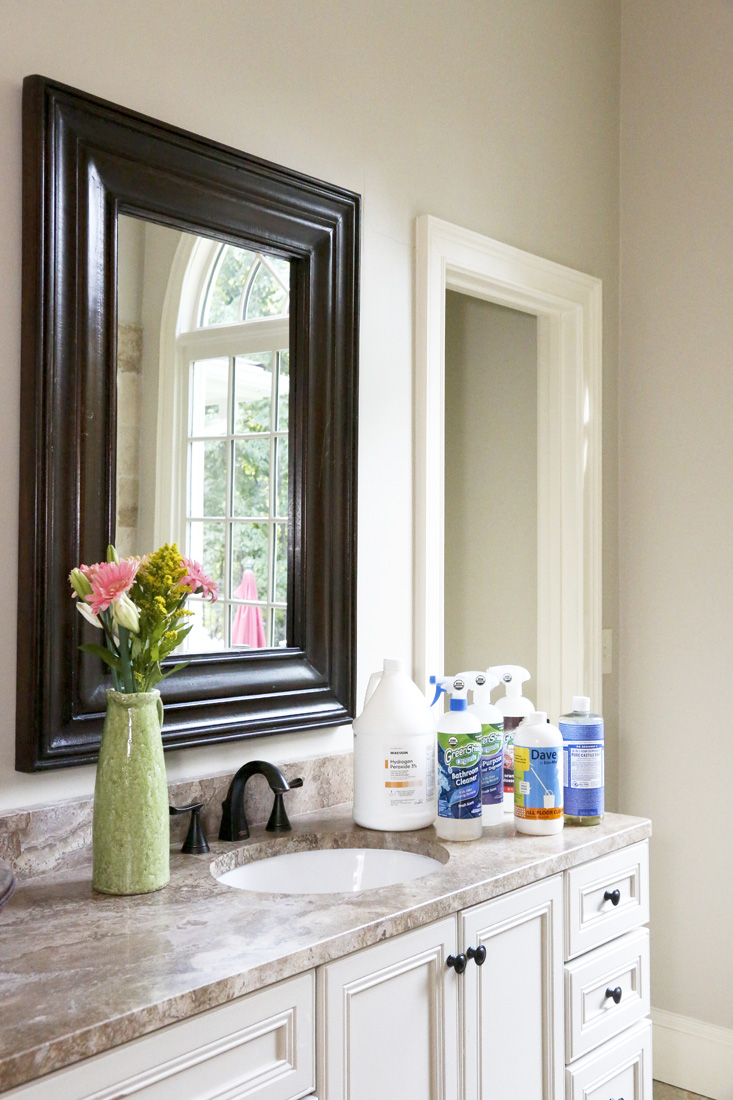Conserve water when you can.
Did you know that around 8 gallons of water is wasted when you don’t turn off the faucet while brushing your teeth? The same goes for shaving. “That’s a huge way to save right there,” Hankey says. “Choose to take showers over baths, have kids bathe together if they’re young enough, fix leaks—little things like that go a long, long way.” Also, when it’s time to purchase a new toilet (since buying a replacement before the old one’s kaput isn’t so eco-friendly), consider a water conserving, low-flow style like the latest models featuring a pull up to flush No. 1 and push down to flush for No. 2. Cooke also recommends switching to automatic motion sensor faucets, low-flow showerheads and an Energy Star-rated bathroom fan with VOC detectors. “And when you do replace things, make sure to send them to the proper place to be recycled, so they don’t end up in a landfill,” Hankey says.
Swap out harsh chemicals.
An essential trade is your typical household bleach. Jeff Dinkle, founder and owner of Eco Custom Homes, a construction firm specializing in high performance and sustainable construction that also provides green home consultations, says, “We don’t allow [chlorine] bleach in our house because of the chlorine gas it can create. Bleach is chlorine. Even when cleaning mold off of bathrooms, bleach just wipes mold off and leaves a chlorine residue. There are better products out there like borax, or boric acid.” Reichert suggests another smart switcheroo with oxygen bleach, the common term for sodium percarbonate, a compound of natural soda crystals and hydrogen peroxide. “Oxygen bleach is a safer alternative to chlorine bleach. It’s even greener than borax.” Look for products that say “chlorine-free bleach,” such as Seventh Generation Free & Clear Chlorine Free Bleach (available at Walmart). Additionally, Reichert says you don’t need harsh chemicals in the bathroom. For example, to prevent soap scum (a.k.a. soap in water that dries and sticks) on fiberglass or tile, just use a squeegee or microfiber cloth after each shower. If that seems too labor-intensive, then spray a vinegar, tea tree oil and essential oil cleaner [see Daily Shower Cleaner recipe] around your shower daily. As for the bathroom toilet, Reichert says, “Instead of putting all sorts of chemicals down the toilet, just use vinegar, borax and hydrogen peroxide [see Toilet Cleaner recipe], which is a great disinfectant.”
DIY DISINFECTANTS
 TOILET CLEANER
TOILET CLEANER
1/4 cup vinegar
1/2 cup borax
3 tablespoons lemon juice or hydrogen peroxide
Heat the vinegar and lemon juice in the microwave for 30 seconds. Mix in the borax until it turns into a paste. Use a stiff brush to apply directly to the mold. Let the mixture set to let the acid in the vinegar and lemon juice kill the mold. Then finish scrubbing the area and rinse with warm water.
 DAILY SHOWER CLEANER
DAILY SHOWER CLEANER
1 cup white vinegar
8 drops tea tree oil
6 drops essential oil for scent
Mix the ingredients and put into a spray bottle. Spray directly onto your shower stall daily. This mixture will keep soap scum and mold to a minimum. It is also good for fighting mold and mildew on shower curtains. Wash the curtain with this mixture in the washing machine with some towels and the daily cleaner to remove the soap scum. Place the curtain in the dryer for just a few minutes to make it warm and easy to hang.
Recipes are from: The Joy of Green Cleaning by Leslie Reichert, available for $14.95 on amazon.com.
Simply Buckhead is an upscale lifestyle magazine focused on the best and brightest individuals, businesses and events in Buckhead, Brookhaven, Sandy Springs, Dunwoody and Chamblee. With a commitment to journalistic excellence, the magazine serves as the authority on who to know, what to do and where to go in the community, and its surroundings.













